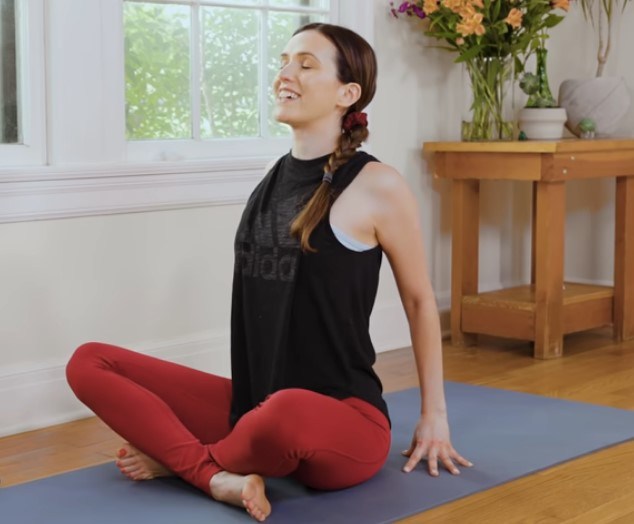Have you ever experienced a severe and also persistent neck pain in the shoulder blade area that just won’t go away? Or how about chronic neck tension while sitting at your desk? You will rightly say that massages feel great, but a few hours later the pain returns, there are yoga exercises for pain.
Upper back and neck strain complaints are becoming more and more prevalent in physical therapy offices, with the increasing use of computers, desk jobs and all the time sitting in traffic, it’s hard to avoid these aches and pains, no matter how active you are.
Why do these things happen?
That’s because most of our daily activities are performed in front of us while sitting. How many hours a day do we spend driving, working, writing or eating? Over time, gravity takes over and the shoulders begin to roll forward, the chest contracts, the head extends and the upper back extends or rounds.
The result of this posture is tight pectorals, a shortened neck and weak upper back muscles, consequently smaller muscles that were not originally designed to be postural muscles have to activate and work hard to keep our bodies upright.
In addition, some sports, including cycling and weights can exacerbate the problem, upper back and neck pain is often just a sign that your muscles are tired from doing a job they were not intended for, the solution is to fix the problem, not the symptoms.
How to apply yoga exercises for neck pain.
In order to combat chronic tension in these areas, you must first work on stretching the tight structures that prevent you from sitting or standing with ideal alignment.
If you strengthen your upper back without stretching the front of your chest, you will simply keep falling back into the same faulty posture, once you open your chest and stretch the back of your neck, then it will be time to work on strengthening your upper back.
Yoga is a wonderful way to achieve both stretching and strengthening in a gentle and effective way, here are some suggested attitudes that you can apply while working, driving, sitting in the office, in your car or at home.
Postural Awareness and Breathing
Belly breathing is important, deep breathing is the first step in relieving neck tension.
When we breathe in a shallow way, the muscles of the neck instead of the diaphragm contract, to begin breathing deeply using the diaphragm, sit upright on the edge of a chair with your feet planted firmly on the floor.
Make sure your knees are lower than your hips, place your hands on your belly and close your eyes, as you inhale, feel your belly rise in your hands and as you exhale, feel it drop, notice any tension in your neck and relax into your neck muscles as you direct your breath into your belly.
As you breathe, bring your awareness to the front of your chest and neck bones, expand the neck bones so that the front of the chest and feel them rise, release the shoulder blades away from the ears and lift the head up towards the sky.
Continue to breathe in this way for 10 deep breaths, try to do this every hour, setting an alarm as a reminder to stop, breathe and notice your posture.

Yoga Clock Stretch
For the clock stretch, stand along a wall and place your right hand on the wall facing 12 o’clock, slowly move your hand from 12 o’clock to 1, 2 and finally to the 3 o’clock position.
Take your left hand and place it on your right rib cage, take a deep breath in and as you exhale, pull your rib cage forward without moving your right arm.
You should feel a stretch in front of the right shoulder or down the right arm, hold for six deep breaths, to intensify the stretch, move closer to the wall, repeat on the other side, if there is any tingling in the arm it is lack of circulation, move away from the wall until it resolves or stop the exercise.
Overhead arms with use of strap
For the strap stretch use a yoga strap or belt, take your arms above shoulder width apart.
Make sure your palms are facing each other, otherwise you can straighten your elbows in this position, place your arms on the belt, place your chin on your chest to relax your neck muscles and pull the strap apart, hold for six deep breaths and repeat twice.

Downward Wall Dog Pose
Downward Wall Dog is performed facing a wall with your hands at waist level, lift your chest bones towards the sky while pressing your hands into the wall.
Feel as if your core is melting towards the floor, if you feel a large amount of stretch in the hamstrings, keep the knees slightly bent, hold this position for six deep breaths, focusing on opening the chest and lengthening the spine.
As with all things, consistency is the key and the more regularly you practise these exercises, the better off you will be.
Ideally, you should get up every hour to stretch for even a minute or two, remember we are fighting a battle against gravity, with regular practice and the right guidance you can stand tall, proud and pain free for life.
It is possible that your pain is coming from a different condition and therefore it is important to consult with a doctor or physiotherapist before starting any yoga exercise programme for pain.
This Other Extraordinary Post «5 Common Yoga Practice Mistakes You Don’t Know About» You might be interested in this post Come in and check it out!!!!
I hope you liked the publication of this article with the emphasis «4 Simple Yoga Exercises for Back and Neck Pain». You can share your opinions and experiences with me in the comments section.


